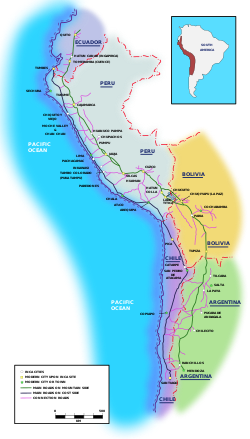Paria, Bolivia
Paria, Bolivia was an important administrative center of the
Paria is located in Cercado Province and Oruro Department of Bolivia.
Incas

Paria existed as a settlement of the
Paria under the Incas, in the words of a
Spanish
In 1535, the conquistador
In 1565, the
The church in Paria has been declared a National Monument by the Bolivian government.[8]
Ruins
The location of Paria la Viexa has been disputed, but a 2010 article locates it 2 kilometres (1.2 mi) east of the present hamlet of Paria. There, scattered over a large area of 100 hectares (250 acres), are the ruins of large buildings, more than 1,000 qullqas for storing grain, and pottery dating mostly from the Inca period. The site is larger than any other known archaeological site in the area, thus strengthening the opinion that this is the site of Paria la Vieja.[9]
References
- ^ Google Earth; Instituto Nacional de Estadistica, "Resultados Censo de Poblacion y Vivienda" 2013, accessed June 9, 2016. "Noticias | CENSOS". Archived from the original on 2014-06-28. Retrieved 2014-05-04.
- ^ Faldon, Juan, Parssinen, Martti, Kesseli Risto, and Faldin, Juan (2010), "Paria, the Southern Inka Capital Rediscovered," Chungara: Revista de Antropologia Chilena, Vol. 42, No. 1, p. 236. Downloaded from JSTOR.
- ^ "About Paria," http://www.projectparia.com/about-paria/, accessed 9 June 2016
- ^ "Hace 476 años el Capitán Juan de Saavedra fundó Paria la Nueva", La Patria http://www.lapatriaenlinea.com/?nota=56188, accessed 9 June 2016
- ^ Faldon, et al; "About Paria." Faldon, et al gives July 15, 1535 as the date for the foundation of Paria.
- ^ Luque Talavan, Miguel (1999), "La Intendencia de Puno: de circunscripcion colonial a departamento de la Republica del Peru (1784-1824)" Revista Complutense de Historia de America, Madrid, "Archived copy" (PDF). Archived from the original on 2011-12-04. Retrieved 2016-07-04.
{{cite web}}: CS1 maint: archived copy as title (link) CS1 maint: bot: original URL status unknown (link) - ^ Mumford, Jeremy Ravi (2012), Vertical Empire: The General Resettlement of Indians in the Colonial Andes, Durham: Duke University Press, pp. 193-195
- ^ "No prospera refaccion en la iglesia de Paria" (2003), La Patria, http://www.lapatriaenlinea.com/?nota=57330, accessed 10 June 20116
- ^ Faldon, et al, pp 235, 243
